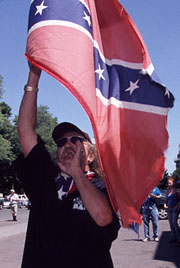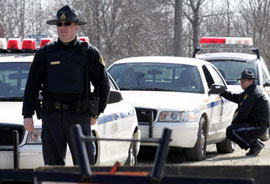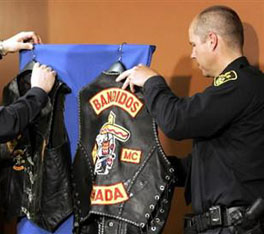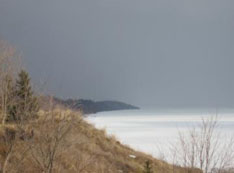Life in jail for Bandidos biker killers in Southwestern Ontario
Nov 1st, 2009 | By Counterweights Editors | Category: In Brief
Wayne Kellestine protests against the London, Ontario gay pride parade in 2005, the year before the Southwestern Ontario biker massacre.
The case of the “worst mass murder in Ontario history” that our roving reporter, Citizen X, first wrote about in the middle of April 2006 has now concluded, at the end of October 2009. It finally solves the late-winter massacre of eight men involved in the Toronto chapter of the Bandidos biker gang, in the same Southwestern Ontario countryside evoked by the late Harvard economist John Kenneth Galbraith, in his 1960s memoir of his Canadian family-farm childhood.
The trial of the six men ultimately charged with the murders, in London, Ontario, moved into high gear this past July. Three of the six had appeared in Citizen X’s first report – Wayne Kellestine, now 60 years old; Frank Mather, 36; and Brett Gardiner, 25. Another man and a woman also mentioned in the first report were not charged in the end. But on June 16, 2006 “police in Winnipeg arrested three additional men, all from that city, in connection with the killings” – Dwight Mushey, 36; Michael Sandham, 36; and Marcello Aravena, 30.

Members of the Ontario Provincial Police set up a barricade outside a farmhouse in the Shedden and Iona Station area of Dutton-Dunwich Township, west of London, Ontario., on April 9, 2006. Officers descended on the rural community after eight bodies were found in several vehicles. (Adrian Wyld/Canadian Press).
The Bandidos biker gang is headquartered in Texas. In 2006 it had only two Canadian chapters. As reported by CBC News: “The Crown successfully argued that the [Southwestern Ontario] murders were the result of rising tensions between the dead men, who were all from the Toronto Bandidos chapter, and a probationary Bandidos chapter in Winnipeg.” A key figure in the massacre was Wayne Kellestine, a former “member of the Toronto chapter” who “had become increasingly alienated from his local chapter and allied himself with the Winnipeg men.”
After hearing evidence for several months, the jury began its deliberations on Wednesday, October 28, 2009. As reported in the Globe and Mail: “Prosecutors successfully made the case that the murders stemmed from a power struggle between the two Canadian chapters, and that the rivalry exploded into violence when the parent Texas group ordered the Toronto Bandidos stripped of their membership.” Crucial evidence (the Toronto Star has explained) came from a “biker who turned informer” and “can only be identified as ‘M.H’.” He testified how he and the “six other men massacred the [Toronto region] Bandidos at the ramshackle farm of … Wayne Kellestine in tiny Iona Station, west of London on the night of April 7-8, 2006.”

Police hang a Bandidos vest up at a press conference at Ontario Provincial Police Headquarters in Elgin County, April 10, 2006.
The jury took only 14 hours to make up its mind. It had heard that “Gardiner, Mather and Aravena didn’t fire any shots in the massacre, but the Crown argued they were an important part of the crime nonetheless.” The upshot was that Kellestine, Mushey, and Sandham were found guilty of eight counts each of first-degree murder. Mather and Aravena were found guilty of one count each of manslaughter and seven counts each of first-degree murder. Gardiner was found guilty of two counts of manslaughter and six counts of first-degree murder. (“A first-degree murder conviction means an automatic life sentence with no parole for 25 years.”)
One place to start for further details is the CBC News “Timeline of the Bandidos massacre,” and/or the related “Chronology of the events in Bandidos slayings” from the Winnipeg Sun. For the most immediate local reporting see the “Bandidos trial coverage” from the London Free Press. There is also inevitable Wikpipedia coverage under the title “Shedden massacre.”

Biker massacre geography: Lake Erie shoreline, Dutton-Dunwich Township, Elgin County, Ontario, March 2009. Jeremy Marks.
For coverage in the Toronto newspapers see “Bikers get life sentences amid families’ palpable grief” and “Abandoned Bandidos massacre scene is a haunting place” in the Globe and Mail; and “Bandidos murder victims’ families tell of lives shattered” and “Kellestine guilty of eight counts of murder at Bandidos trial … Five co-accused guilty of numerous charges including murder and manslaughter” in the Toronto Star.
To end on a suitably mournful note, “Marilyn DiFlorio, mother of murdered Bandido Frank Salerno, 43, of [the Greater Toronto Area town of] Oakville, said in a victim impact statement in a packed courtroom …’Your Honour, I know that when this tragedy occurred that many ignorant individuals expressed the opinion that the world would be a better place with eight less bikers … This deeply saddened me because Frank was my son.’”

go-weiner-go and take cry baby brian with you….